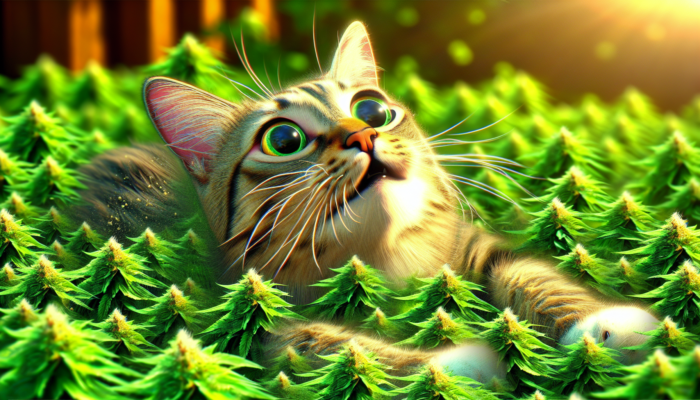Exploring the Intriguing Effects of Catnip on Feline Behavior
Understanding Catnip: The Herb and Its Unique Active Ingredient

Catnip, scientifically referred to as Nepeta cataria, is a member of the mint family and is famously known for its remarkable ability to evoke captivating reactions in many cats. This enchanting response is primarily due to its active compound, nepetalactone, found in the leaves, stems, and seeds of the plant. When nepetalactone interacts with a cat’s olfactory receptors, it triggers a powerful and varied response, ensuring that each feline has a uniquely delightful experience that can be both amusing and surprising.
As cats interact with catnip—whether through sniffing, chewing, or rolling around in it—they typically exhibit a wide spectrum of behaviors that can be both entertaining and mystifying for their human companions. These behaviors may include vocalizations such as purring and meowing, playful rolling, and a host of other delightful antics. The effects of catnip generally last from just a few minutes up to about 30 minutes, after which cats might temporarily lose interest in the herb. Interestingly, not all felines respond to catnip; sensitivity to this captivating herb is hereditary, with research indicating that approximately 50-70% of cats display a favorable reaction to it.
The influence of nepetalactone extends beyond mere entertainment; it also plays a significant role in the health and well-being of cats. The euphoric sensations triggered by catnip can foster playfulness and exploration, which are vital for maintaining a cat’s mental and physical vitality. For cat owners eager to enhance their furry companions’ lives, grasping the essence of catnip and the way in which its active ingredient works is essential to maximizing its benefits.
Delving into the Neuroscience of Catnip's Enchantment
The mesmerizing effects of catnip can be traced to its profound impact on a cat's neurological system. When nepetalactone is inhaled, it swiftly travels to the brain, stimulating neurons that govern a cat's behavior. This activation ignites a cascade of neurochemicals, particularly dopamine, which is integral to the brain's reward system. The release of these pleasurable hormones leads to the euphoric and sometimes hyperactive behaviors that many cat owners frequently observe in their pets, creating a visually entertaining spectacle.
While the immediate effects of catnip are undeniably captivating, it is equally important to consider the long-term effects on a cat’s behavior and mental health. Regular exposure to catnip can invigorate a cat's inherent instincts, promoting hunting behaviors and encouraging physical activity. This is especially beneficial for indoor cats, who might otherwise lack sufficient stimulation in their daily lives. However, it is crucial to monitor the frequency of catnip exposure to prevent overstimulation, which could lead to irritability or even aggressive behaviors in certain felines.
Ongoing studies continue to unveil the complexities of how catnip influences various felines. Research indicates that responses may vary not just among individual cats but also across different breeds. For instance, specific breeds such as Siamese and Abyssinians appear to have heightened sensitivity to catnip, whereas others demonstrate minimal reaction. Current investigations aim to explore the neurological pathways involved and their contributions to the overall feline experience with this captivating herb.
Understanding the Timing and Frequency of Catnip Responses
Comprehending the timing and frequency of a cat’s reaction to catnip is essential for responsible cat ownership. Typically, the effects of catnip last between 5 to 15 minutes following initial exposure. Once these effects dissipate, cats may show temporary disinterest in catnip for about 30 minutes to two hours. This natural cycle of sensitivity is crucial for maintaining a cat’s interest and ensuring they do not become desensitized to the effects of catnip, which could diminish the joy it brings.
For cat owners, timing and moderation are key elements in the effective use of catnip. Frequent exposure can reduce its efficacy, as cats may become accustomed to its effects over time. It is advisable to limit exposure to once every few days, allowing cats to fully enjoy the stimulating benefits without risking boredom or overstimulation, which could lead to undesirable behavioral changes.
Observing your cat’s reactions to catnip can provide valuable insights into determining the ideal frequency for your furry friend. Some cats may exhibit heightened enthusiasm, while others may respond in a more subdued manner. Customizing catnip exposure based on your cat’s individual preferences not only enhances their enjoyment but also enriches their overall well-being, creating an optimal balance between stimulation and relaxation.
Analyzing Catnip's Effects on Feline Behavior

The Delightful Behavior of Rolling and Rubbing in Catnip
One of the most entertaining and distinctive behaviors exhibited by cats under the influence of catnip is their propensity to roll and rub against it. This behavior often manifests as cats enthusiastically rolling on the ground, rubbing their bodies against catnip-infused items, and even vocalizing with loud purring. But what compels cats to engage in these amusing actions?
Rolling and rubbing are instinctive behaviors that serve multiple purposes. Primarily, these actions enable cats to effectively scent-mark their territories. By rolling in catnip, cats not only indulge in the herb but also leave their unique scent on it, claiming it as part of their space. This primal behavior can be traced back to their wild ancestors, who relied on scent for communication and establishing their presence in their environment.
Furthermore, the act of rolling and rubbing creates a sensory experience that stimulates both physical and mental engagement. This playful behavior promotes physical exercise, which is essential for maintaining a healthy weight and muscle tone. Additionally, the euphoric sensations triggered by nepetalactone encourage cats to embrace their playful nature, leading to more interactive playtime and bonding opportunities with their human companions.
It is crucial to observe your cat during these joyful moments. While rolling and rubbing are generally harmless behaviors, excessive rolling can occasionally lead to skin irritations or injuries, particularly if the surface is rough or abrasive. Creating a safe environment for your cat to indulge in these behaviors ensures they can fully enjoy the delightful effects of catnip without encountering any negative consequences.
Enhancing Playfulness Through Catnip
Another remarkable effect of catnip on cats is the significant boost in playfulness it can induce. When cats come into contact with catnip, their natural instincts often intensify, resulting in bursts of energy and enthusiasm. This heightened playfulness can manifest in a variety of behaviors, including chasing toys, pouncing, and engaging in mock hunts—all of which are crucial for their overall physical and mental health.
The stimulating effects of catnip can transform a lethargic cat into an agile and playful companion. For indoor cats, who may lack the same environmental stimuli as their outdoor counterparts, catnip serves as a vital tool for promoting active play. Providing catnip-infused toys can significantly enhance playtime, allowing cats to engage in their natural behaviors that foster exercise and mental stimulation.
It's important to recognize that an increase in playfulness is not solely about physical activity. Engaging in play also helps alleviate stress levels and improves a cat’s mood, making it an essential aspect of feline well-being. For cat owners, incorporating catnip into playtime can strengthen the bond between you and your feline friend. The shared enjoyment of playful antics fosters a more enriched relationship, as your cat begins to associate fun and joy with your presence.
However, while the increased playfulness is generally beneficial, it is crucial to ensure a safe environment for your cat to explore. Securing toys and ensuring they are free from small parts that could pose a choking hazard is vital. With the right approach, catnip can be a magical enhancement to your cat’s playtime routine, boosting their happiness and overall well-being.
Utilizing Catnip to Soothe Anxious Cats

Although catnip is commonly associated with heightened playfulness and excitement, it also possesses potential calming effects for anxious or stressed felines. The ability of nepetalactone to evoke feelings of euphoria can translate into relaxation for some cats, offering a soothing effect during stressful circumstances.
Many cat owners have found that introducing catnip during times of anxiety—such as thunderstorms or vet visits—can help ease their cat’s nervousness. The natural properties of the herb can foster a sense of well-being, making it easier for cats to cope with stressful stimuli. This duality—acting as both a stimulant and a calming agent—makes catnip a versatile addition to a cat owner’s toolkit for managing feline stress.
Beyond the immediate calming effects, regular exposure to catnip can contribute to a more balanced emotional state over time. Cats that engage frequently with catnip may develop increased resilience to stressors, as the herb helps cultivate positive associations with their environment. This is especially beneficial in multi-cat households, where competition for resources can lead to stress and tension among the cats.
To harness the calming properties of catnip, consider creating a dedicated space where your cat can enjoy the herb in peace. Whether it’s a cozy nook filled with catnip-infused toys or a scratching post sprinkled with dried catnip, providing a tranquil environment allows your cat to relax and unwind, thereby enhancing their quality of life.
Effective Ways to Utilize Catnip for Your Cats
Leveraging Catnip in Training Sessions
Incorporating catnip into training routines can be an incredibly effective strategy for reinforcing desired behaviors in your feline companion. The allure of catnip acts as a powerful motivator, transforming training sessions into enjoyable experiences for both you and your cat.
When introducing catnip as a reward, timing is crucial. It’s best to offer it immediately after positive behaviors occur, so your cat forms an association between the behavior and the pleasurable experience of catnip. For example, if your goal is to teach your cat to use a scratching post instead of the furniture, sprinkling some catnip on the post can serve as an enticing lure. This positive reinforcement encourages them to engage with the scratching post more frequently.
Moreover, catnip can transform training sessions from mundane tasks into delightful games. By incorporating play with catnip into your training routine, you can heighten your cat’s motivation to learn. Using catnip during clicker training or to encourage your cat to perform tricks can enhance their focus and willingness to participate, making the process more enjoyable for both of you.
It's essential to monitor your cat’s reactions during training sessions that involve catnip. Some cats may become overly excited and lose focus, making effective training challenging. Adjust the amount of catnip used based on your cat’s temperament and energy levels, ensuring that training remains a positive experience.
Choosing the Right Catnip Toys and Accessories
Selecting the perfect catnip-infused toys and accessories can significantly enhance your cat’s enjoyment and interaction with the herb. The market offers a wide variety of options, ranging from plush toys filled with dried catnip to sprayable catnip for refreshing existing toys. Understanding the different types of products available will help you choose the best ones for your feline friend.
One popular option is catnip pillows or stuffed toys designed for cuddling, rolling, and playful enjoyment. These toys can spark your cat’s curiosity and prompt them to engage in playful behaviors. Look for toys that are well-constructed and made from safe materials, ensuring they can withstand the enthusiastic play that typically accompanies catnip enjoyment.
Another excellent choice is catnip sprays, which can revitalize worn-out toys or even furniture. Spraying catnip on scratching posts or climbing structures can entice your cat to use them more frequently, redirecting their energy toward appropriate activities that promote healthy play.
When introducing new catnip products, observe your cat’s reactions and preferences. Some cats may prefer specific textures or types of toys, while others may show indifference. By tailoring your selections to your cat’s unique tastes, you can maximize their enjoyment of catnip and create a more stimulating environment for them.
Managing Catnip Usage in Multi-Cat Households
Overseeing catnip consumption in multi-cat households can present distinct challenges. While some cats may revel in the effects of catnip, others might become territorial or aggressive when vying for access to it. Understanding how to navigate these dynamics is essential for maintaining harmony among your feline companions.
One effective strategy is to introduce catnip in a controlled manner. Instead of providing a large quantity of catnip all at once, consider offering it to each cat separately, allowing them to relish the herb without feeling threatened by their housemates. This approach can help reduce competition and foster a more positive experience for all cats involved.
Additionally, consider rotating catnip toys or accessories to keep each cat engaged without overwhelming them. By allowing cats to experience catnip at different times, you can ensure that each cat has an opportunity to enjoy the effects without conflict.
It is also important to monitor your cats’ reactions during these sessions. If one cat tends to dominate the catnip experience, it may be necessary to establish boundaries and ensure that all cats have equal opportunities to enjoy their time with the herb. This approach not only promotes a peaceful environment but also enriches their lives by allowing each cat to experience the delightful effects of catnip without stress or anxiety.
Health and Safety Considerations for Catnip Use in Cats
Ensuring Catnip Safety for Your Feline Companion
While catnip is generally regarded as safe for most felines, it’s crucial to understand that not all cats will respond positively to it. Some cats may experience mild gastrointestinal upset if they consume excessive amounts of catnip, while others may show no adverse effects at all. This variability underscores the importance of moderation when integrating catnip into your cat’s routine.
Kittens under the age of three to six months typically do not exhibit sensitivity to catnip, as they have not yet developed the necessary receptors that respond to the herb. Furthermore, certain medical conditions or medications may influence a cat’s reaction to catnip. Consulting with your veterinarian before introducing catnip is advisable, especially for senior cats or those with underlying health concerns.
Monitoring your cat’s behavior after exposure to catnip is vital. If you observe any signs of distress, such as excessive vocalizations, aggressive behavior, or vomiting, it may indicate that catnip is not suitable for your cat. In such situations, discontinuing use and seeking guidance from your veterinarian can help safeguard your cat’s health and well-being.
Identifying Risks Associated with Catnip Overuse
While catnip can provide enjoyable experiences for felines, overexposure can lead to overstimulation. Signs of overstimulation may include hyperactivity, aggression, or a temporary disinterest in play. It is essential for cat owners to recognize these signs and adjust the frequency and amount of catnip provided accordingly.
To prevent overstimulation, it is advisable to limit catnip exposure to once every few days. This interval allows your cat to savor the herb without becoming desensitized to its effects. Additionally, creating a calm and quiet environment after a catnip session can help your cat regain their composure.
If a cat becomes overly excited or aggressive during a catnip session, it may be beneficial to remove the source of catnip and provide a serene space for them to calm down. This approach ensures that your cat can enjoy the stimulating effects of catnip while maintaining a balanced emotional state.
In summary, recognizing the signs of overuse and adjusting exposure accordingly is crucial for fostering a healthy relationship with catnip. By practicing moderation and mindfulness, you can ensure that your cat enjoys the advantages of catnip without potential drawbacks.
Exploring Alternative Options to Catnip for Your Feline Friend
While catnip is cherished by many felines, it’s important to consider alternatives for those cats who may not respond to it or require different types of stimulation. Fortunately, several other herbs and plants can evoke comparable reactions in cats, offering exciting new avenues for play and enjoyment.
One popular alternative is silver vine (also known as Actinidia polygama), which has been shown to trigger playful behaviors in cats that do not respond to catnip. Its unique compounds can provide a delightful experience, making it an excellent addition to a cat’s toy collection.
Another option is valerian root, which can produce calming effects in some cats while still promoting playful behaviors. The terpenoids found in valerian root can create sensations of euphoria similar to those induced by catnip, making it a worthwhile alternative for cats who may not enjoy catnip.
In addition to these herbs, many commercial cat toys now incorporate a mix of various enticing scents, including catnip, silver vine, and valerian root. Experimenting with these alternatives can provide new experiences for your cat, enriching their environment and enhancing their overall well-being.
In conclusion, while catnip is a beloved herb for many cats, exploring alternatives can offer additional stimulation and enjoyment for those who may not respond to traditional catnip products.
Understanding How Age and Breed Impact Catnip Responses
Introducing Kittens to the Wonders of Catnip
A common question among cat owners is when kittens can start to experience the delightful effects of catnip. Generally, the ability to respond to catnip develops around three to six months of age. Before this age, kittens typically lack the necessary receptors to react to the active compound, nepetalactone.
Introducing catnip to kittens should be done thoughtfully. It’s best to wait until they reach the appropriate age to ensure they can safely enjoy the herb without adverse reactions. Once your kitten reaches the right age, offering small amounts of catnip can encourage playfulness and stimulate their natural hunting instincts, fostering healthy development.
When introducing catnip to kittens, consider using toys infused with catnip rather than providing it in its raw form. This method allows for controlled exposure and promotes interactive play. Observ














